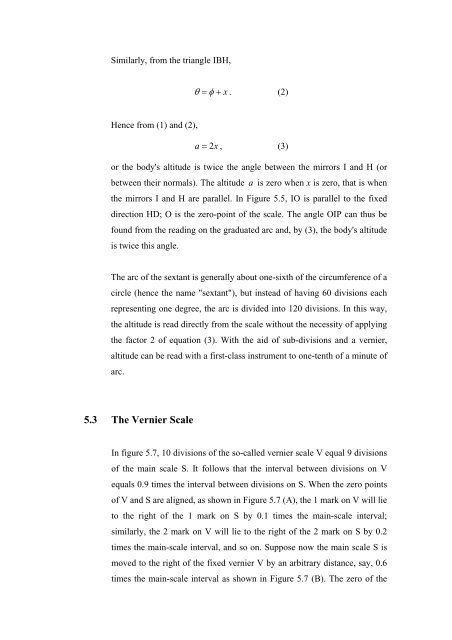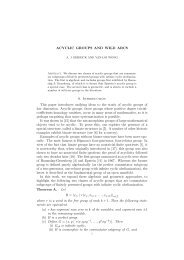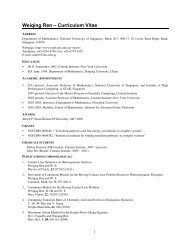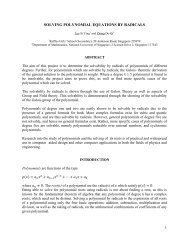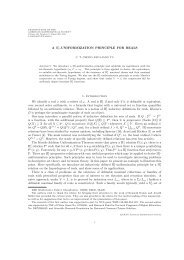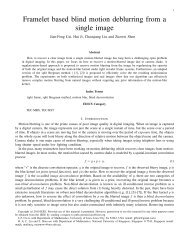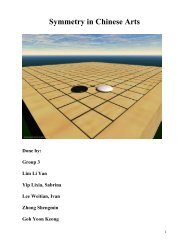The Mathematics of the Longitude - Department of Mathematics
The Mathematics of the Longitude - Department of Mathematics
The Mathematics of the Longitude - Department of Mathematics
You also want an ePaper? Increase the reach of your titles
YUMPU automatically turns print PDFs into web optimized ePapers that Google loves.
Similarly, from <strong>the</strong> triangle IBH,<br />
Hence from (1) and (2),<br />
θ = φ + x . (2)<br />
a = 2 x , (3)<br />
or <strong>the</strong> body's altitude is twice <strong>the</strong> angle between <strong>the</strong> mirrors I and H (or<br />
between <strong>the</strong>ir normals). <strong>The</strong> altitude a is zero when x is zero, that is when<br />
<strong>the</strong> mirrors I and H are parallel. In Figure 5.5, IO is parallel to <strong>the</strong> fixed<br />
direction HD; O is <strong>the</strong> zero-point <strong>of</strong> <strong>the</strong> scale. <strong>The</strong> angle OIP can thus be<br />
found from <strong>the</strong> reading on <strong>the</strong> graduated arc and, by (3), <strong>the</strong> body's altitude<br />
is twice this angle.<br />
<strong>The</strong> arc <strong>of</strong> <strong>the</strong> sextant is generally about one-sixth <strong>of</strong> <strong>the</strong> circumference <strong>of</strong> a<br />
circle (hence <strong>the</strong> name "sextant"), but instead <strong>of</strong> having 60 divisions each<br />
representing one degree, <strong>the</strong> arc is divided into 120 divisions. In this way,<br />
<strong>the</strong> altitude is read directly from <strong>the</strong> scale without <strong>the</strong> necessity <strong>of</strong> applying<br />
<strong>the</strong> factor 2 <strong>of</strong> equation (3). With <strong>the</strong> aid <strong>of</strong> sub-divisions and a vernier,<br />
altitude can be read with a first-class instrument to one-tenth <strong>of</strong> a minute <strong>of</strong><br />
arc.<br />
5.3 <strong>The</strong> Vernier Scale<br />
In figure 5.7, 10 divisions <strong>of</strong> <strong>the</strong> so-called vernier scale V equal 9 divisions<br />
<strong>of</strong> <strong>the</strong> main scale S. It follows that <strong>the</strong> interval between divisions on V<br />
equals 0.9 times <strong>the</strong> interval between divisions on S. When <strong>the</strong> zero points<br />
<strong>of</strong> V and S are aligned, as shown in Figure 5.7 (A), <strong>the</strong> 1 mark on V will lie<br />
to <strong>the</strong> right <strong>of</strong> <strong>the</strong> 1 mark on S by 0.1 times <strong>the</strong> main-scale interval;<br />
similarly, <strong>the</strong> 2 mark on V will lie to <strong>the</strong> right <strong>of</strong> <strong>the</strong> 2 mark on S by 0.2<br />
times <strong>the</strong> main-scale interval, and so on. Suppose now <strong>the</strong> main scale S is<br />
moved to <strong>the</strong> right <strong>of</strong> <strong>the</strong> fixed vernier V by an arbitrary distance, say, 0.6<br />
times <strong>the</strong> main-scale interval as shown in Figure 5.7 (B). <strong>The</strong> zero <strong>of</strong> <strong>the</strong>


